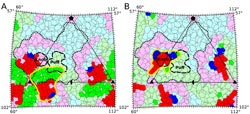Findings point to potential treatment for virus causing childhood illnesses

These images illustrate antibody "footprints" outlined in yellow on the surface of a virus called EV71. Three distinct proteins - out of a total of 180 - that make up the viral capsid are outlined in blue, green, and red. The neutralizing antibodies E18 (A) and E19 (B), used in this study were found to bind to the viral proteins where the colors are bright. The E18 antibody causes the viral capsid to open, resulting in the loss of the viral genome, suggesting the virus no longer has the ability to replicate in the human host. (Department of Biological Sciences, Purdue University) <br>
The virus, called enterovirus 71 (EV71), causes yearly outbreaks of hand, foot, and mouth disease in Southeast Asian countries including China and Malaysia. Some of the infected children develop encephalitis that can be fatal or result in permanent brain damage. There are no anti-EV71therapeutic agents available.
The researchers prepared antibodies by immunizing mice with immature EV71 particles. Antibodies generated by this immunization induced a change in the mature EV71 virus, rendering it non-infectious by causing the virus particles to lose their genome.
The findings reveal a potential treatment mechanism, demonstrating that the antibody, called E18, has potential as an anti-EV71 therapy, said Michael G. Rossmann, Purdue's Hanley Distinguished Professor of Biological Sciences.
Findings are being reported this week in Proceedings of the National Academy of Sciences. The paper was authored by Purdue postdoctoral research associate Pavel Plevka; Pei-Yin Lim, a researcher from Sentinext Therapeutics in Penang, Malaysia; Purdue research scientist Rushika Perera; Jane Cardosa, a researcher at Sentinext and MAB Explorations in Malaysia; Purdue graduate student Ampa Suksatu; Richard J. Kuhn, a professor and head of Purdue's Department of Biological Sciences; and Rossmann.
EV71 belongs to a family of viruses called picornaviruses, pathogens that cause diseases including common-cold-like illnesses and poliomyelitis in people and chronic infections in livestock.
“The antibody-mediated virus neutralization by the induction of genome release has not been previously demonstrated,” Rossmann said. “These results indicate that antibodies with genome-release activity could also be produced for other picornaviruses by immunization with immature particles. The approach could be used to prepare antibodies with similar properties against related viruses that include significant human pathogens.”
Researchers observed and documented the loss of genome using two laboratory techniques: cryoelectron microscopy and a fluorescent SYBR Green dye assay.
Hand, foot and mouth disease, an infection most common among young children, sometimes arises in a daycare setting. Of the 427,278 cases of the disease recorded in China between January and May 2010, 5,454 cases were classified as severe, with 260 deaths, according to the World Health Organization.
The research has been funded by the National Institutes of Health.
Writer: Emil Venere, 765-494-4709, venere@purdue.edu
Sources: Pavel Plevka, 765-494-8712, plevka@purdue.edu
Michael Rossmann, 765-494-4911, mr@purdue.edu
Richard J. Kuhn, 765-494-4407, kuhnr@purdue.edu
Rushika Perera, perera@purdue.edu
Note to Journalists: A copy of the research paper is available by contacting Emil Venere, 765-494-4709, venere@purdue.edu
Media Contact
More Information:
http://www.purdue.eduAll latest news from the category: Health and Medicine
This subject area encompasses research and studies in the field of human medicine.
Among the wide-ranging list of topics covered here are anesthesiology, anatomy, surgery, human genetics, hygiene and environmental medicine, internal medicine, neurology, pharmacology, physiology, urology and dental medicine.
Newest articles

High-energy-density aqueous battery based on halogen multi-electron transfer
Traditional non-aqueous lithium-ion batteries have a high energy density, but their safety is compromised due to the flammable organic electrolytes they utilize. Aqueous batteries use water as the solvent for…

First-ever combined heart pump and pig kidney transplant
…gives new hope to patient with terminal illness. Surgeons at NYU Langone Health performed the first-ever combined mechanical heart pump and gene-edited pig kidney transplant surgery in a 54-year-old woman…

Biophysics: Testing how well biomarkers work
LMU researchers have developed a method to determine how reliably target proteins can be labeled using super-resolution fluorescence microscopy. Modern microscopy techniques make it possible to examine the inner workings…





















